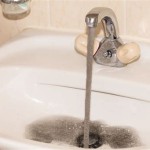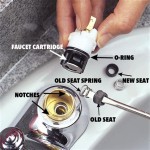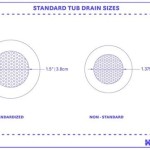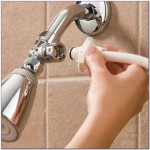How to Clean Grease Off Bathtub
Grease in a bathtub is a common household problem, particularly for individuals who use the bathtub for washing pets, cleaning greasy tools, or who have plumbing systems that are not adequately maintained. Grease can accumulate from soaps, body oils, and shampoo residue as well, forming a stubborn film that is both unsightly and difficult to remove. The buildup not only makes the tub less appealing but also creates a slippery surface, increasing the risk of slips and falls. This article provides a comprehensive guide to effectively clean grease off a bathtub, detailing various methods and preventative measures to keep the tub sparkling and safe.
Before beginning any cleaning process, it is crucial to identify the type of bathtub material. Bathtubs are commonly made from acrylic, porcelain-enameled cast iron, or fiberglass. Using the wrong cleaning product or technique can damage the surface. For instance, abrasive cleaners can scratch acrylic and fiberglass, while harsh chemicals can dull the finish of porcelain. Once the bathtub material is identified, the appropriate cleaning methods and products can be selected.
Safety is paramount when dealing with cleaning agents. Adequate ventilation is essential, so open windows or turn on the bathroom exhaust fan. Protective gloves should be worn to protect the skin from irritation caused by cleaning solutions. Eye protection, such as goggles, is also recommended, particularly when working with spray cleaners or chemical solutions. Mixing different cleaning products can create hazardous fumes, so it is critical to avoid combining cleaners unless specifically instructed to do so by the product's label.
Initial Preparation: Removing Loose Debris and Rinsing
The first step in cleaning a greasy bathtub involves removing any loose debris, such as hair, soap scum, or other particles. A dry cloth or paper towel can be used to wipe away surface dirt. Removing this debris before applying cleaning solutions will allow the cleaners to more effectively target the grease and grime. A preliminary rinse with warm water helps to loosen up some of the grease and prepares the surface for deeper cleaning.
After removing loose debris, a thorough rinse with warm water is necessary. Warm water helps to soften the grease, making it easier to lift off the surface. Ensure the entire tub is wet before applying any cleaning solution. This pre-wetting step will enhance the efficacy of the cleaning agents and prevent them from drying too quickly, which can make the cleaning process more challenging.
Cleaning with Common Household Ingredients
Many effective methods for cleaning grease off a bathtub involve readily available household ingredients. These options are generally less harsh than commercial cleaners and are often more environmentally friendly. Baking soda and vinegar, dish soap, and lemon juice are all effective and inexpensive alternatives.
Baking soda is a mild abrasive that can help to scrub away grease without scratching the bathtub surface. To use baking soda, sprinkle a generous amount over the greasy areas and let it sit for about 15-20 minutes. The baking soda will absorb some of the grease and loosen its grip on the tub. After the waiting period, scrub the area with a damp sponge or cloth. For particularly stubborn grease, make a paste by mixing baking soda with a small amount of water or vinegar. Apply the paste to the greasy areas and let it sit for 30 minutes before scrubbing and rinsing thoroughly.
Vinegar is an acidic cleaner that can dissolve grease and grime. White vinegar or apple cider vinegar can be used. To clean with vinegar, fill a spray bottle with undiluted vinegar and spray it liberally onto the greasy areas of the bathtub. Let it sit for about 30 minutes to allow the vinegar to break down the grease. After the waiting period, scrub the area with a sponge or cloth and rinse thoroughly with warm water. For extra cleaning power, vinegar can be combined with baking soda. However, it is important to note that the mixture will fizz, so it is best to apply it in small amounts.
Dish soap is designed to cut through grease, making it an effective cleaner for a greasy bathtub. Select a dish soap that is specifically formulated for grease removal. Apply a generous amount of dish soap to a sponge or cloth and scrub the greasy areas of the bathtub. For tougher grease, let the dish soap sit for a few minutes before scrubbing. Rinse thoroughly with warm water to remove any soap residue.
Lemon juice is a natural degreaser and disinfectant. It can be used to clean mild grease buildup and to freshen the bathtub. To use lemon juice, cut a lemon in half and rub the cut side directly onto the greasy areas of the bathtub. Let the lemon juice sit for about 15 minutes before scrubbing and rinsing thoroughly with warm water. Alternatively, lemon juice can be mixed with water in a spray bottle and applied to the bathtub surface.
Using Commercial Cleaning Products
When household ingredients are not sufficient to remove stubborn grease, commercial cleaning products may be necessary. There are numerous commercially available degreasers and bathtub cleaners that are specifically designed to target grease and grime. When using commercial products, it is imperative to follow the manufacturer's instructions carefully to avoid damaging the bathtub surface or causing harm to oneself.
Grease-cutting bathroom cleaners are formulated to dissolve grease and soap scum. These cleaners typically contain surfactants and solvents that break down the grease molecules. When using a grease-cutting bathroom cleaner, spray it liberally onto the greasy areas of the bathtub and let it sit for the recommended time, usually a few minutes. After the waiting period, scrub the area with a sponge or cloth and rinse thoroughly with warm water. It is important to ensure adequate ventilation when using these cleaners, as they can sometimes have strong odors.
Enzyme cleaners utilize enzymes to break down organic materials like grease and soap scum. These cleaners are generally gentler than traditional chemical cleaners and are often biodegradable. To use an enzyme cleaner, spray it onto the greasy areas of the bathtub and let it sit for the recommended time, usually several hours or overnight. The enzymes will gradually break down the grease and grime. After the waiting period, scrub the area with a sponge or cloth and rinse thoroughly with warm water.
Abrasive cleaners, such as powdered cleansers or scrub pads, can be effective for removing stubborn grease buildup. However, these cleaners should be used with caution, as they can scratch delicate bathtub surfaces like acrylic or fiberglass. If using an abrasive cleaner, test it on an inconspicuous area of the bathtub first to ensure it does not cause damage. Apply the cleaner sparingly and scrub gently to avoid scratching the surface. Rinse thoroughly with warm water to remove any abrasive residue.
Before using any commercial cleaning product, reading the label and understanding the potential risks is essential. Many commercial cleaners contain harsh chemicals that can be harmful if inhaled or ingested. Always wear gloves and eye protection when using commercial cleaners, and ensure adequate ventilation in the bathroom. Avoid mixing different cleaning products, as this can create dangerous fumes. If any adverse reactions occur, such as skin irritation or difficulty breathing, discontinue use immediately and seek medical attention.
Techniques for Stubborn Grease Removal
Sometimes, grease buildup can be particularly stubborn and require more intensive cleaning techniques. These techniques may involve using specialized tools or combining multiple cleaning methods.
The "bagged vinegar" method is effective for cleaning showerheads or faucets that have grease and mineral buildup. To use this method, fill a plastic bag with white vinegar and secure it around the showerhead or faucet with a rubber band or tape. Ensure that the showerhead or faucet is fully submerged in the vinegar. Let the bag sit for several hours or overnight. The vinegar will dissolve the grease and mineral deposits. After the soaking period, remove the bag and scrub the showerhead or faucet with a brush. Rinse thoroughly with warm water.
Steam cleaning is a method that utilizes hot steam to loosen and dissolve grease and grime. A steam cleaner can be used to clean the entire bathtub, including the walls and floor. The hot steam penetrates deep into the grease, making it easier to wipe away. When steam cleaning, wear protective gloves and eye protection. Direct the steam nozzle at the greasy areas of the bathtub and move it slowly back and forth. After steam cleaning, wipe the area with a clean cloth to remove any loose debris.
Utilizing a plastic scraper or an old credit card serves as a mechanical method to remove hardened grease. These tools can be used to gently scrape away thick layers of grease without damaging the bathtub surface. Hold the scraper at an angle and apply gentle pressure to avoid scratching the tub. After scraping, clean the area with a cleaning solution and rinse thoroughly with warm water.
Combining multiple cleaning methods can enhance grease removal. For example, baking soda and vinegar can be combined, or a commercial degreaser can be used after pre-soaking the area with dish soap. When combining cleaning methods, be cautious not to mix chemicals that could create hazardous fumes. Always rinse thoroughly between applications of different cleaning products.
Preventative Measures to Minimize Grease Buildup
Preventing grease buildup in the bathtub is easier than removing it. Implementing preventative measures can significantly reduce the frequency and intensity of cleaning required. Regular cleaning, proper plumbing maintenance, and using soap and shampoo dispensers can all help to minimize grease accumulation.
Regular cleaning is key to preventing grease buildup. Wiping down the bathtub after each use can prevent grease and soap scum from accumulating. Use a clean cloth or sponge to wipe away any excess water, soap residue, or body oils. A quick daily wipe-down can significantly reduce the need for more intensive cleaning.
Plumbing maintenance plays a crucial role in preventing grease from accumulating in the bathtub. Ensure drains are properly functioning and free of clogs. Regularly flush the drain with hot water to help dissolve any grease that may be building up in the pipes. Consider using a drain strainer to catch hair and other debris that can contribute to clogs. Avoid pouring grease down the drain, as this can lead to significant plumbing problems.
Switching to soap and shampoo dispensers can help to minimize grease buildup. Bar soaps and bottled products often leave residue that can contribute to grease accumulation. Using dispensers reduces the amount of residue that comes into contact with the bathtub surface. Select dispensers that are easy to clean and refill to prevent buildup within the dispenser itself.
By implementing these preventative measures, individuals can minimize grease buildup in their bathtubs and maintain a clean and safe bathroom environment. Consistent cleaning and proper maintenance are essential for preventing grease accumulation and ensuring that the bathtub remains a pleasant and hygienic space.

How To Deep Clean A Bathtub Taskrabbit Blog

How To Clean Tough Stains From A Bathtub 4 Easy Methods

This Weird Bathtub Cleaning Trick Will Save Your Back Knees

My Dirty Little Secret For A Sparkling Clean Bathtub

This Weird Bathtub Cleaning Trick Will Save Your Back Knees

Baking Soda Bleach And Vinegar Which Is Best For A Clean Bathtub 2025

How To Clean An Acrylic Tub Or Shower 9 Best Cleaners

How To Clean A Non Slip Bathtub Bottom Like New Everyday Skate

This Weird Bathtub Cleaning Trick Will Save Your Back Knees

How To Clean Your Bathtub Diy Family Handyman
Related Posts








